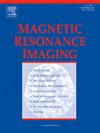Depth-dependent characterization of cartilage nanostructures using MRI signal decays
IF 2
4区 医学
Q2 RADIOLOGY, NUCLEAR MEDICINE & MEDICAL IMAGING
引用次数: 0
Abstract
Objective
The multi-exponential nature of echo decay in nuclear magnetic resonance exam of cartilage complicates the determination of relaxation times. In this study, a novel method has been developed and applied to analyze the cartilage nanostructure using multi-exponential signals. This approach eliminates the need for relaxation time determination, avoids sample rotation, and removes the requirement for multiple experiments. A key feature of this method is its ability to provide detailed insights into the nanostructures of the sample.
Methods
Quantitative T2 imaging method was used to examine the signal delays in mature and healthy canine articular cartilage, at a transverse resolution of 35.1 μm. A modeling method was used to analyze the multi-exponential echo decay for each resolved tissue depth along the full thickness of articular cartilage.
Results
The developed approach provides detailed information on the nanostructure in the tissue, which varies with cartilage depth. The information contains the volumes of the water-filled nanocavities created by the fibril structure and their orientation. This information reveals that the superficial and transitional anatomic zones of cartilage contain two distinct types of nanocavities, while the radial zone contains only one type.
Discussion
The proposed voxel-based method of echo decay analysis enables the estimation of nanocavities, their angular distribution, and spatial variations of the nanocavity characteristics throughout the sample. This newly developed approach demonstrated that detailed structural tissue information can be obtained as a depth function, representing a significant advancement in understanding cartilage nanostructures and holds potential for future medical applications.

基于MRI信号衰减的软骨纳米结构深度依赖性表征
目的软骨核磁共振检查回声衰减的多指数性质使松弛时间的测定复杂化。本研究提出了一种利用多指数信号分析软骨纳米结构的新方法。这种方法消除了对松弛时间测定的需要,避免了样品旋转,并且消除了对多次实验的要求。这种方法的一个关键特点是它能够提供对样品纳米结构的详细了解。方法在35.1 μm的横向分辨率下,采用定量T2成像方法检测成熟和健康犬关节软骨的信号延迟。采用建模方法,沿关节软骨全厚度分析各分解组织深度的多指数回波衰减。结果该方法提供了组织中随软骨深度变化的纳米结构的详细信息。这些信息包含由纤维结构和它们的方向产生的充满水的纳米空腔的体积。这一信息揭示了软骨的表面和过渡解剖区包含两种不同类型的纳米空洞,而径向区只包含一种类型。所提出的基于体素的回波衰减分析方法能够估计纳米空腔、它们的角分布以及整个样品中纳米空腔特征的空间变化。这种新开发的方法表明,详细的结构组织信息可以作为深度函数获得,代表了在理解软骨纳米结构方面的重大进步,并具有未来医学应用的潜力。
本文章由计算机程序翻译,如有差异,请以英文原文为准。
求助全文
约1分钟内获得全文
求助全文
来源期刊

Magnetic resonance imaging
医学-核医学
CiteScore
4.70
自引率
4.00%
发文量
194
审稿时长
83 days
期刊介绍:
Magnetic Resonance Imaging (MRI) is the first international multidisciplinary journal encompassing physical, life, and clinical science investigations as they relate to the development and use of magnetic resonance imaging. MRI is dedicated to both basic research, technological innovation and applications, providing a single forum for communication among radiologists, physicists, chemists, biochemists, biologists, engineers, internists, pathologists, physiologists, computer scientists, and mathematicians.
 求助内容:
求助内容: 应助结果提醒方式:
应助结果提醒方式:


